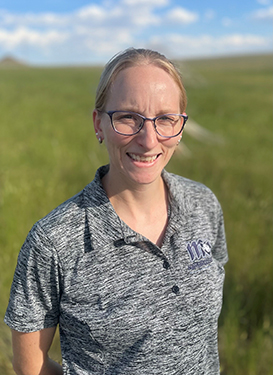A Wyoming coal mine might be the last place you’d
think to be investing in research on next-generation renewable energy strategy,
but that’s exactly what Amy McBrayer, Ph.D., has undertaken during doctoral
studies at South Dakota Mines.
Her work focuses on building mathematical models to
help surface mining companies strategize and plan mining operations around
renewable power availability, using energy generated from renewable power
sources to run the mine during peak energy production times and slowing down
mine production when less renewable power is available.
McBrayer says many mining companies have plans to
reduce carbon emissions at their operations in the coming years, and this
challenge is compounded by the accelerating demand for raw materials in the
global economy.
“If we’re not constantly working to improve
efficiencies, we won’t meet this increasing demand while continuing to reduce
carbon intensity and energy use at these operations,” says McBrayer.
Part of her effort is to show that aligning power
consumption with renewable power availability reduces the environmental impact
of power generation and also improves the bottom line for mining companies. “We
are really trying to help mining companies make decisions on what technology to
employ to increase efficiencies and meet demand,” she says.
 McBrayer just
completed her doctorate under Andrea Brickey, Ph.D., a professor of mining
engineering and management at South Dakota Mines. McBrayer says surface mines,
such as coal mining operations in the Powder River Basin of Wyoming, can
actually help lead technology development in renewable energy and in other areas.
McBrayer just
completed her doctorate under Andrea Brickey, Ph.D., a professor of mining
engineering and management at South Dakota Mines. McBrayer says surface mines,
such as coal mining operations in the Powder River Basin of Wyoming, can
actually help lead technology development in renewable energy and in other areas.
“Some mining companies have built their own
renewable systems on site that not only benefit them but also the local
utilities and their customers,” says Brickey. “There have been a lot of
renewables sited on reclaimed mine lands,” McBrayer adds. “In Wyoming, we have
a wind farm on the former part of the Dave Johnston site. Other mines in the US
are looking at solar development on reclaimed mine lands as well.”
Brickey notes that there is not a “one size fits all”
approach to the application of renewable energy in the mining industry.
“The discussion is site specific; one mine may have
excellent prospects for solar and wind, another may have access to geothermal.
Hydrogen is also being looked at for some mines as a fuel for machinery and
vehicles,” says Brickey. “New mines coming online are looking at the latest
technology to meet production needs in a safer and more environmentally friendly
manner. Companies are also looking at technology to help increase efficiency —
especially in a challenging hiring environment,” McBrayer adds.
McBrayer and Brickey both point out that mining is
necessary for the materials needed in everyday life, from the critical minerals
that enable your smartphone to the high carbon steel in a surgeon’s scalpel.
They add that today, coal is essential for baseload power and grid reliability.
“The use of thermal coal for power generation is
likely to continue for decades, even with current carbon emissions targets, and
updating production scheduling practices for this region to maximize renewable
power usage at mine sites benefits both the producer and the consumer,” McBrayer
says.
McBrayer spent several years in industry as an
engineer before coming back to academia for a Ph.D. to explore the effort to
help coal operations continue to provide energy thought the transition to
renewables. “It’s been really fulfilling to look at things in the broader view
than I could as an engineer working on the front-line,” she says.
Brickey adds that the mining industry is facing
major workforce needs in the coming years that will include a huge focus on
environmental protection.
“We need engineers who are focused on sustainability.
It’s something that is integrated into everyone’s role on a mine site. What can
we do to be more efficient in a continually changing environment,” says
Brickey.
In the next phase of her career, McBrayer is joining
the faculty at West Virginia University where she will continue her research and
work to inspire the next generation of mining engineers.